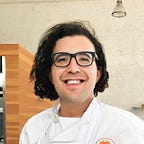Pastry Chef School: Jams, Candying, Caramel, Sugars and Fats
This week at Pastry School we baked test muffins with different fats & sugars, cooked jams, candied fruits & nuts, cultured butter and developed our signature granola. For our first week at Pastry school we focused on flour. This second week was about sugars and fats. And next week is all about eggs.
We started “sugar week” by making jams and marmalades. Jams are pureed fruit combined with sugar and spices. Marmalades are jams that also have pieces of the edible peel. Most of these sit overnight in sugar, potentially pureed and than cooked to 221°F–230°F.
How to make fruit Jam (raspberry): cover fruit with sugar in a 4:5 ratio respectively and cover overnight. Strain and simmer juice until 228°F. Finally combine with fruit and boil until 222°F. Add acid (balsamic, lemon juice, etc) and salt to season.
How to candy citrus (Buddha’s Hand): cut buddha’s hand to same sized pieces and blanche for 40m. Strain and cover fruit in simple syrup w/ invert sugar. Cook until 230°F and store covered in syrup.
How to make lemon Marmalade (citrus): remove peel, slice lemons thinly, cover 1:4 ratio water overnight and simmer for 3h until passes spoon test. Halfway through add tons of sugar and spices.
Making caramel is about heating sugar up to 320°F and eyeballing doneness based on the darkness of the caramel before it burns at 350°F. At 310°F sugar mixtures contain 100% sugar and 0% water. Caramel can either be made using the wet method (sugar + water + invert sugar) or dry method (sugar + #yolo).
Making Dark Caramel using the dry method: With a thin uniform layer of sugar cover the bottom of a saucepan. Heat. Only swirl to combine after dark Caramel forms and is about to burn.
To make candied almonds make a caramel in a pan, dump nuts in there swish around to coat with caramel and then add a tiny bit of fat (e.g. cocoa butter). Pour on silpat and separate with your nimble hands.
This week we learned about making muffins by creaming butter with sugar, adding eggs, and then alternating wet & dry ingredients. We baked muffins with the same ratios and different sugars (e.g. maple, sugar, brown sugar, etc). Evaluating crumb texture of different sugars:
- Granulated sugars like sugar, turbinado sugar, superfine sugar and brown sugar had the best crumb texture. The sugar particles creamed into the butter and created fairly regular crumbs.
- Whereas powdered sugar was absorbed by liquid and only aerated using baking powder. As such it was much denser.
- Wetter sugars like brown sugar, honey and maple were delicious but had a much more irregular crumb texture with much bigger air pockets due to steam.
We also made the same creamed butter muffins with different fats.
- Butter muffins had a very regular crumb texture.
- Olive oil and coconut oil muffins had a more moist mouthfeel and tasted great.
- Duck fat muffins tasted bad and didn’t get a nice rise from creaming. (there’s probably recipe development that could make them taste better)
- Shoterning muffins has a much more breaky crust than butter muffins.
What else did we do this week?
- We made cultured butter. Combine 10:1 ratio cream : buttermilk, let sit for 24h and agitate to make butter.
- We made ricotta. 1:10 ratio of milk : cream with 0.01% citric acid and salt. Cook until 195°F, let rest for 10m and strain through cheesecloth.
- Zen of sugar work: Different stages of sugar syrup have different water%. Thread 230–235°F is 80% sugar-20% water. Soft ball 235–240°F is 85% sugar. Hard ball 240–250°F is 87% sugar. Once sugar syrup hits 310°F it’s 100% sugar.
- We developed our signature granola. Went from black sesame paste to tahini.
Read more about my pastry education by reading about last week:
